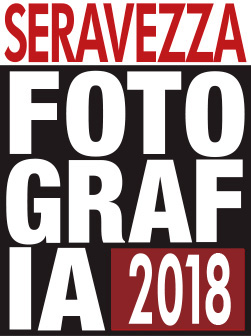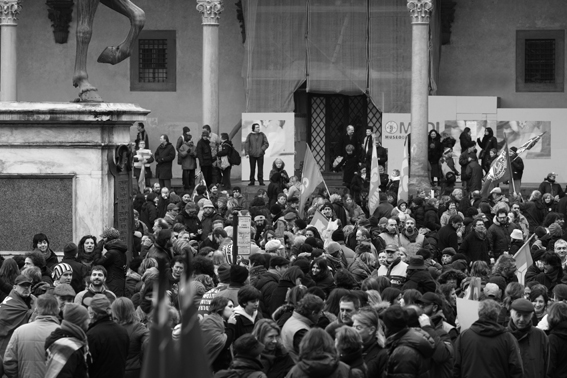

curated by Niccolò Lucarelli

STRIKE
Text by Niccolò Lucarelli
Lucio Trizzino was professionally born as an architect and a restorer of monumental buildings, and he has worked, for examples, at the temples of Segesta and Agrigento, the Cathedral of Monreale, and various Italian archaeological parks. For many years, he has been using photography as a means of professional investigation and documentation of architecture and historical territory, but since a couple of decades ago, this second "profession" has become an exclusive interest, purposing to understand the human passions.
Sicilian man of ancient descent - few words and searching glance -, Trizzino tells human stories with the lens of his camera, to whom he commits thoughts, doubts, feelings, emotions,
who regularly reflect themselves on the film not as cold data of experience, but as short poems, a kind of refined haiku with whom they share the simple tones, without any title, eliminating lexical delays and rhetorical images, making a synthesis of thought and image.
During these years, seven photographic books were born, each one with its own “personality”: Place of clichés (2008), Winds of futuristic photography (2010), Strike (2011), Train (2012), Anxiety (2013), Guangdong (2015), Musae (2016). They all build a great “fresco” of contemporary reality, Italian and international, human and artistic.
STRIKE contains three of these volumes: Place of clichés, Strike, Anxiety, where Trizzino’s glance wants to explore our present, to enlighten the thoughts of the people, to discover their doubt, anxieties, expectations, ambitions, and thus tracing their history, using the film as if it was a blank page to fill with words, both poetic and prosaic, adding the concept to the image. Three chapter who range over social and political reportage, three trips in images developed with the frame of the social novel, both with verist atmosphere (like Zola o Capuana) and with metaphoric atmosphere (like Swift or Sterne). From these “pages on film” it emerge the human being and its soul, the urban landscape, the marginalized community of “Arco di San Pierino” in Florence, the disorientation of Italian people. This is a difficult tale, sometimes painful, but useful and necessary to reflect upon the way our society is going.
We have chosen to entitle the exhibition “Strike” (an exhibition that could be inconvenient), because the word “strike” refers to one of its section, but also because it means “to hit”, “to surprise”, “to begin a conversation”. And Trizzino,’s images really make this: they strike the observer with their human and conceptual strength, they surprise him with their aesthetic boldness, and finally they involve him in a conversation both ironic and dramatic.
Being in Seravezza means for Trizzino squaring the circle, because the similarity between his photography and Enrico Pea’s fiction (we have to remember that Pea was Born in Seravezza). Like the Versilian writer, Trizzino covers the reality with new meanings and possibilities of reading, without judging anyone or anything. Instead, he lets us understand his sympathy for weakness and contradictions of human beings. And human being is always present, even when the image has only landscapes or objects: they are the meters and the witnesses of life, with its conflicts and its problems. But we don’t’ find fatalism in this approach, because even between opposite sensations, Trizzino is looking for harmony. An harmony that, as Sicilian man with a Greek past, he has in his blood. In these photography, you can always find the implicit will that the story Trizzino tells could find its balance, its dignity.
Strike

The last two strikes organized in Florence by the FIOM (October 2009, March 2010) became the occasion for a reflection on a political and social past that has had an important role in the recent Italian history, as well for a comparison with a present diametrically opposed. Indifference, (when not detachment), characterizes the political feeling of our times, and Lucio Trizzino - without arrogating to himself the right to judge the effects, but only following the objectivity of the camera -, documents with care, sensitivity and a little irony, how the strikes of the Third Millennium are very different from those of the Sixties and Seventies, and how enthusiasm and trust in certain ideals and structures no more existing.
The result is the indirect image of a country tired and discouraged, but above all flattened, disoriented, and who regrets this disappointing situation. Flags and banners are not enough to fill the gaps left by an enthusiasm and a conviction that exist no more. The interpretation moves from the political level to the purely social one, as in Trizzino’s style: the strike is overshadowed, it is merely a pretext to feel the pulse of society, to investigate its aspirations and expectations. The fil rouge with Anxiety gently emerges, because here we have, first of all, the absence of a purpose.
With a theatrical comparison, the strikers could be thought as Pirandello's Six Characters, desperately searching for an author. But above all, it lacks individuality. This gallery of faces, on which Trizzino focuses, denounces the involution of a social body that became mass, adorned with those symbols who are always the same (fashion clothes or the attributes of the protest), and even worn with the same philosophy, as if they were signs of genuine distinction.
The contrast between the young and the old militants is very striking: the latter appear as the survivors of ancient battles, bring in the look nostalgia for enthusiasms of the past, while young people seem to take part to a worn script, or maybe an unexpected occasion to play hooky.
This is an intense work of social and psychological documentation, carried out with the lingering with the camera on the glances and the expressions of the strikers, which become a means to explain our contemporaneity. And, on the background, solemn and distant, almost mocking, Piazza Santissima Annunziata with its timeless beauty, its harmony (mirror of the Renaissance society), that contemporary society has lost long time ago.
Anxiety

Anxiety seems to be the constant of our time, insecurity dominates our lives: an economic, emotional, and personal insecurity. Poses and unexpected glimpses, creating disturbing illusions, or maybe unusual realities, that beget a sensation of insecurity. Sixteen chapters between big cities and small towns, that investigate the art, the absence, the loneliness, the waiting. Unusual shots, misplaced objects, individuals by indecipherable expression, or just waiting, street artists. Just to tell suspended situations, where “before” and “after” fade in a precarious “now”, fraught with innumerable questions. A conceptual photography of social investigation, characterized by a peculiar, aesthetic language, made of contrasts between light and shadow, full and empty, ancient and modern. So, a discussion internal to the image sets up, even before than with the observer, a dialectic which shows an aesthetic harmony that does not correspond to the conceptual level; these 121 shots (of which a selection is shown here), reveals a varied and complex human universe, plunged in an everyday reality which is too often painful, almost always potentially conflictual.
It is in particular in this volume that Trizzino’s photographic fiction is very close to Enrico Pea’s one; the reality brought to our attention - anxiety-inducing, nervy, problematic -, assumes unusual force and meaning, from which emerge the hidden essence of bodies, objects, perspectives, positions, lights and shadows, which - combined together and fixed by the camera -, become metaphor of misunderstandings, loneliness, distances, silences. A distance, a shadow or a normal object, are not simply what they seem, but rise as instruments of knowledge, indirect means to measure the absent soul. You could say that Trizzino also works through sensations and prints, which are the traces of actions, thoughts, feelings, fears. Just like Pea, he identifies the eternity of time, with the difference that the living substance does not emerge here: the dark wing of this journey through images and metaphors, it’s the absence of the soul, absence that the author points out already in the title of the book, being anxiety, and melancholy, a slowly fading.
Place of clichés

By meeting and talking about the humanity that gravitated under the Arco di San Pier Maggiore, Lucio Trizzino moves to a small area that, until a few years ago, was paradoxically regarded as downtown, despite its position in the city center. The reason: it was frequented by "unconventional" people, whose hard lives made them outcasts of society. The title uses pun to explain a heterogeneous community, too often judged only on the basis of appearances, without knowing the complex stories that are hidden inside. San Pierino - as this maze of streets is affectionately called by the Florentines -, become a symbolic place where you can understand the absurdity and falsity of a certain way of judging other people.
Almost every photo is supported by a thought, a short sentence written by the same person portrayed, which opens his soul to the observer, with discretion and a certain shyness, but also with sincerity. The wall of clichés falls like a house of cards, because just beyond the certainties, it turns out a composite human universe, made of suffering and self-destruction. Young people, adults, men, women, Italians, foreigners, artists, dreamers, naives, drifters: a heterogeneous community, held together only by the street, by the desire of oblivion sought in alcohol or other drugs. An extreme escape from a life that has become intolerable.
Trizzino’s work goes beyond art photography and assumes a narrative feature, close to the social, verist novels by Zola or Verga, and, with rare sensitivity, carries out an anthropological investigation on lives that could have been successful, if they had not been stopped by the brutal circumstances of life. The author gives a voice to these women and these men, allowing them to associate a thought to each of the photograph that portraits them individually: reflections, observations, questions and answers result, with an astonishing poetic and philosophical sensibility.
Just to say that humanity is much more than a grey zone prey to drug addiction and degradation. Trizzino’s tragic and intimate photography goes beyond the concept of "writing of light" to be "writing of soul", and lets talks those faces, those expressions, those looks, that belong to individuals, whose human dignity comes here to a new life. If there is a merit that this reportage can boast, this is to shake consciences, to understand how the human beings always maintain their dignity and their spiritual wealth, and how difficulties of life can’t be a social stigma.
Now, the Arco di San pier Maggiore has been radically restored, and the social contest has deeply changed. So these photos belong now to history.
Niccolò Lucarelli